stop start TOYOTA CAMRY 2013 XV50 / 9.G Quick Reference Guide
[x] Cancel search | Manufacturer: TOYOTA, Model Year: 2013, Model line: CAMRY, Model: TOYOTA CAMRY 2013 XV50 / 9.GPages: 32, PDF Size: 1.91 MB
Page 4 of 32

2
OVERVIEW
Instrument panel
Steering wheel audio controls1,2,3
Telephone controls1,2
Voice command button1,2,3
Ignition switch (standard key)1
Cruise control
Paddle shift switches1
Headlight and turn signal controls/Headlight, turn signal and front fog
light1 controls
Wiper and washer controls
Clock
Audio system
1/Navigation system1,2/Display audio system1,3
“ENGINE START STOP” button (Smart Key)1
Tilt and telescopic steering lock release
Air Conditioning controls
Emergency flasher button
Outside rearview mirror
1/Rear window defogger button
12V DC power outlet
AUX or USB/AUX port
Seat heater controls
1
BSM (Blind Spot Monitor) main switch1
VSC OFF switch
Headlight leveling dial1
Coin holder
1 If equipped2 For details, refer to the “Navigation System Owner’s Manual.”3 For details, refer to the “Display Audio System Owner’s Manual .”
NOTE: For vehicles equipped with Entune
TM, please consult the “Navigation
System With Entune Quick Reference Guide” or www.toyota.com/entune.
Steering wheel controlsAutomatic Air Conditioning
Type A
Type B
127601_2013Camry.indd 211/19/12 10:28 PM
Page 8 of 32
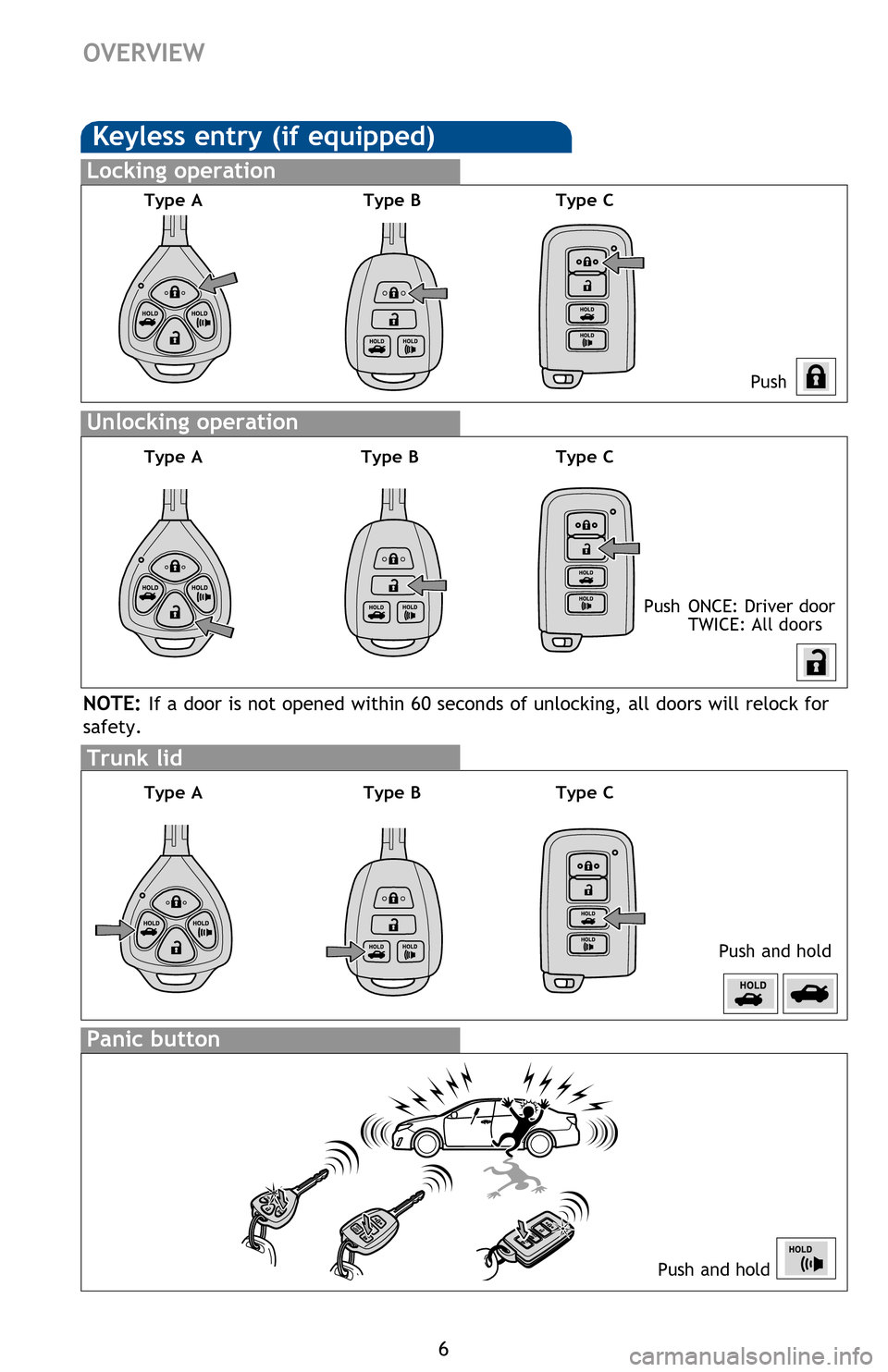
6
OVERVIEW
Keyless entry (if equipped)
Push
Push ONCE: Driver door
TWICE: All doors
Locking operation
Unlocking operation
Type A Type B
Smart Key system (if equipped)
Start function
ACC
ON
OFF
NOTE: Gear shift lever must be in Park and brake pedal depressed.
Without depressing the brake pedal, pressing the “ENGINE START STOP” switch
will change the operation mode in succession from:
* Driver door unlocking function can be programmed to unlock driver door only, or
all doors. Grasping front passenger door handle will unlock all doors.
NOTE: Doors may also be locked/unlocked using remote.
Power (without starting engine)
Panic button
Push and hold
NOTE: If a door is not opened within 60 seconds of unlocking, all doors will relock for
safety.
Trunk lid
Push and holdTrunk lock/unlock
Locking operation
Carry remote to lock
Front door lock
Carry remote to lock/unlock
Type C
Type A
Type A Type B
Type B Type C
Type C
127601_2013Camry.indd 611/19/12 10:29 PM
Page 9 of 32
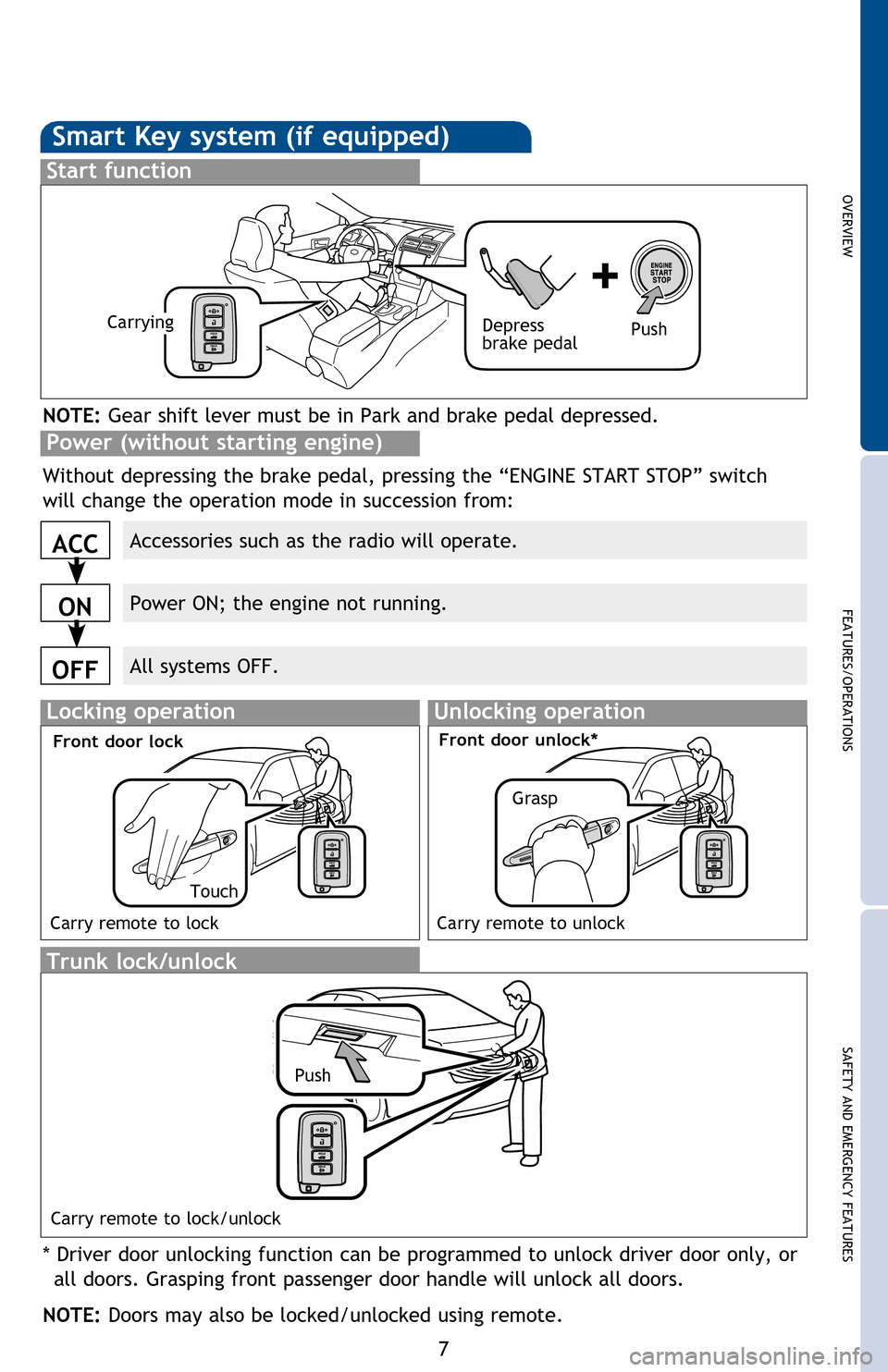
OVERVIEW
FEATURES/OPERATIONS
SAFETY AND EMERGENCY FEATURES
7
Push ONCE: Driver door
TWICE: All doors
Smart Key system (if equipped)
Start function
Accessories such as the radio will operate.
Power ON; the engine not running.
All systems OFF.
ACC
ON
OFF
NOTE: Gear shift lever must be in Park and brake pedal depressed.
Push
Depress
brake pedalCarrying
Without depressing the brake pedal, pressing the “ENGINE START STOP” switch
will change the operation mode in succession from:
* Driver door unlocking function can be programmed to unlock driver door only, or
all doors. Grasping front passenger door handle will unlock all doors.
NOTE: Doors may also be locked/unlocked using remote.
Power (without starting engine)
NOTE: If a door is not opened within 60 seconds of unlocking, all doors will relock for
safety.
Push and holdTrunk lock/unlock
Push
Locking operationUnlocking operation
Carry remote to lock Carry remote to unlock
Front door lock
Carry remote to lock/unlock
Front door unlock*
TouchGrasp
127601_2013Camry.indd 711/19/12 10:29 PM
Page 12 of 32
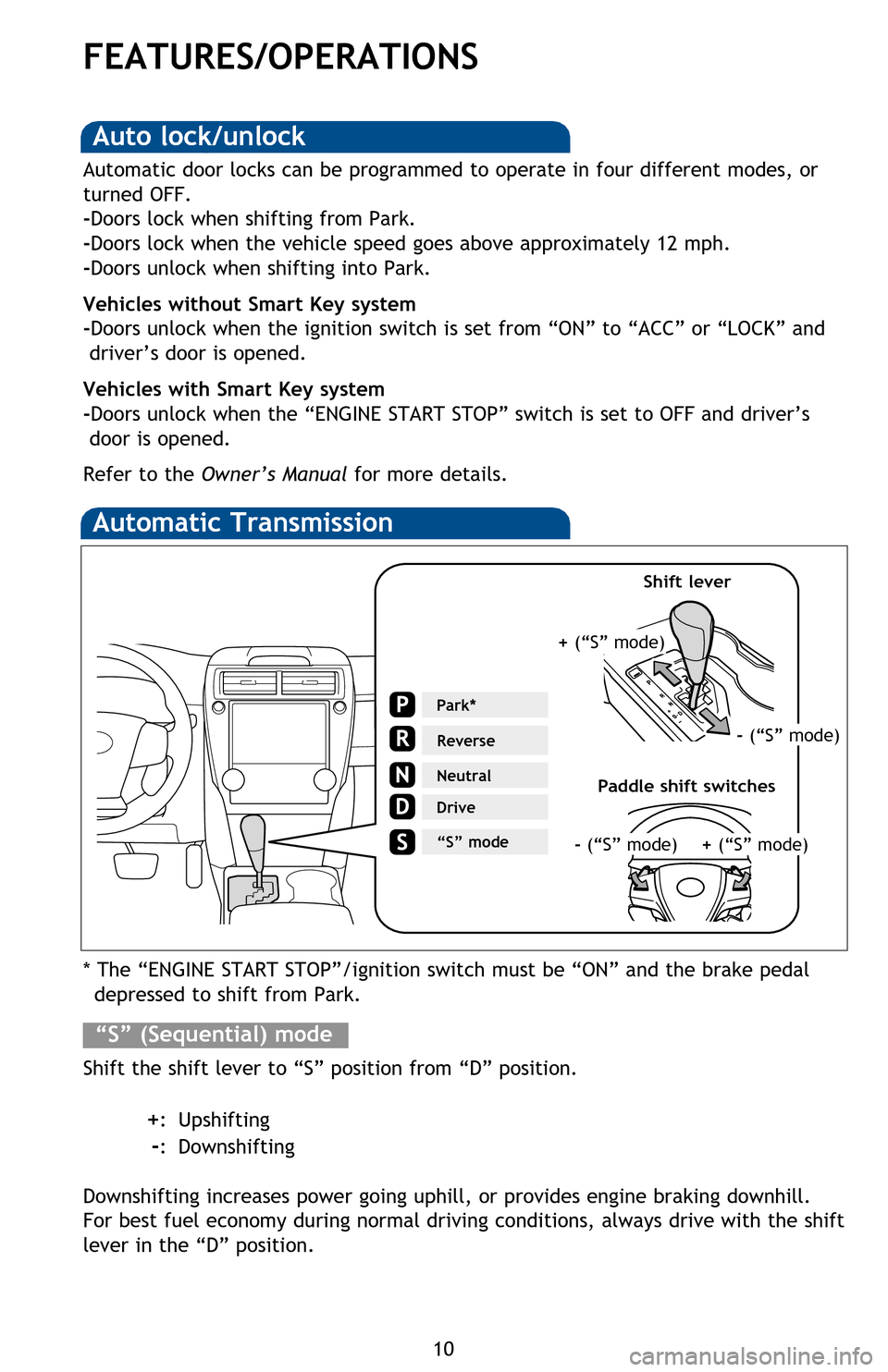
10
FEATURES/OPERATIONS
Automatic Transmission
* The “ENGINE START STOP”/ignition switch must be “ON” and the brake pedal depressed to shift from Park.
Shift the shift lever to “S” position from “D” position.
+: Upshifting
-: Downshifting
Downshifting increases power going uphill, or provides engine braking downhill.
For best fuel economy during normal driving conditions, always drive with the shift
lever in the “D” position.
“S” (Sequential) mode
Steering lock release
Smart Key system*
Parking brake
Park*
Reverse
Neutral
Drive
N
“S” mode
Auto lock/unlock
Automatic door locks can be programmed to operate in four different modes, or
turned OFF.
-Doors lock when shifting from Park.
-Doors lock when the vehicle speed goes above approximately 12 mph.
-Doors unlock when shifting into Park.
Vehicles without Smart Key system
-Doors unlock when the ignition switch is set from “ON” to “ACC” or “LOCK” and driver’s door is opened.
Vehicles with Smart Key system
-Doors unlock when the “ENGINE START STOP” switch is set to OFF and driver’s door is opened.
Refer to the Owner’s Manual for more details.
Hold wheel, push lever down, set angle and length, and return lever.
NOTE: Do not attempt to adjust while the vehicle is in motion.
Tilt and telescopic steering wheel
* Gently turn steering wheel while pressing the
“ENGINE START STOP” switch. If the lock does
not release, the Smart Key system indicator
will flash quickly (green).
+ (“S” mode)
- (“S” mode)
+ (“S” mode)- (“S” mode)
Paddle shift switches Shift lever
127601_2013Camry.indd 1011/19/12 10:29 PM
Page 13 of 32
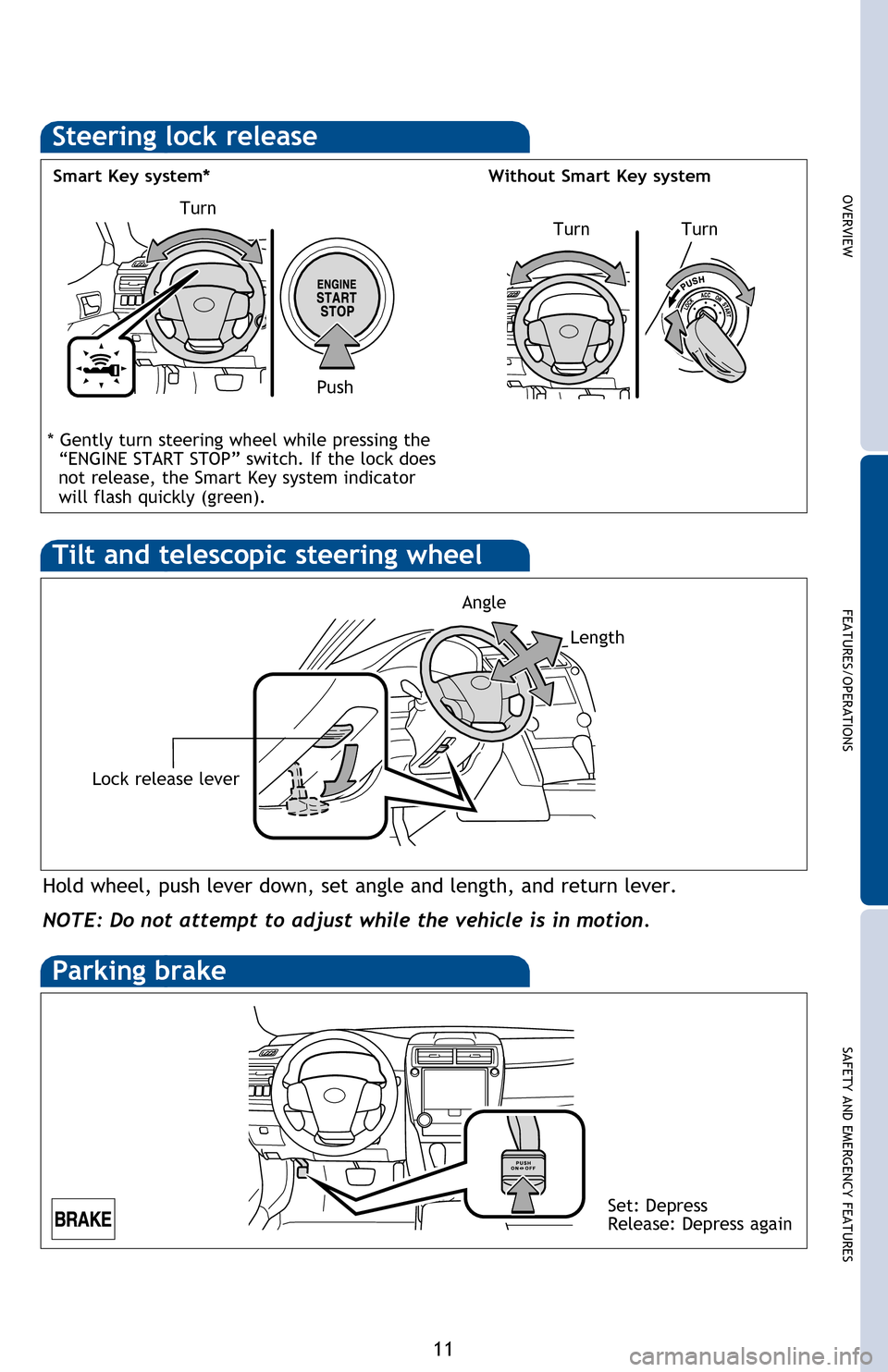
OVERVIEW
FEATURES/OPERATIONS
SAFETY AND EMERGENCY FEATURES
11
* The “ENGINE START STOP”/ignition switch must be “ON” and the brake pedal depressed to shift from Park.
Shift the shift lever to “S” position from “D” position.
+: Upshifting
-: Downshifting
Downshifting increases power going uphill, or provides engine braking downhill.
For best fuel economy during normal driving conditions, always drive with the shift
lever in the “D” position.
Steering lock release
Turn
Turn
Smart Key system*
Without Smart Key system
Push
Turn
Parking brake
Automatic door locks can be programmed to operate in four different modes, or
turned OFF.
-Doors lock when shifting from Park.
-Doors lock when the vehicle speed goes above approximately 12 mph.
-Doors unlock when shifting into Park.
Vehicles without Smart Key system
-Doors unlock when the ignition switch is set from “ON” to “ACC” or “LOCK” and
driver’s door is opened.
Vehicles with Smart Key system
-Doors unlock when the “ENGINE START STOP” switch is set to OFF and driver’s door is opened.
Refer to the Owner’s Manual for more details.
Set: Depress
Release: Depress again
Hold wheel, push lever down, set angle and length, and return lever.
Lock release lever
NOTE: Do not attempt to adjust while the vehicle is in motion.
Tilt and telescopic steering wheel
* Gently turn steering wheel while pressing the
“ENGINE START STOP” switch. If the lock does
not release, the Smart Key system indicator
will flash quickly (green).
Angle
Length
- (“S” mode)
+ (“S” mode)
127601_2013Camry.indd 1111/19/12 10:29 PM
Page 16 of 32

14
Power outlets-12V DC
Front console
The “ENGINE START STOP” switch/ignition switch must be in the “ACC” or “ON”
position for use.
Center console (if equipped)
Lights & turn signals
Turn signals
Headlights
Front fog lights (if equipped)
-Daytime Running Light system (DRL) Automatically turns on the headlights at a reduced intensity.
-Automatic light cut off system Automatically turns lights off after 30-second delay, or lock switch on remote may be pushed after locking.
Parking lights
Windshield wipers & washers
Adjust frequency*
Pull to wash and wipeSingle wipe
Interval wipe
Slow
Fast
Front fog lights come on only when the headlights are on low beam.
FEATURES/OPERATIONS
* Intermittent windshield wiper frequency adjustment
Rotate to increase/decrease wipe frequency.
Type A
Type B
Pull to wash and wipe
Single wipe
Interval wipe
Slow
Fast
Type B
Type A
Parking lights
1 The right hand signals will flash 3 times.2 The left hand signals will flash 3 times.
127601_2013Camry.indd 1411/19/12 10:30 PM
Page 17 of 32
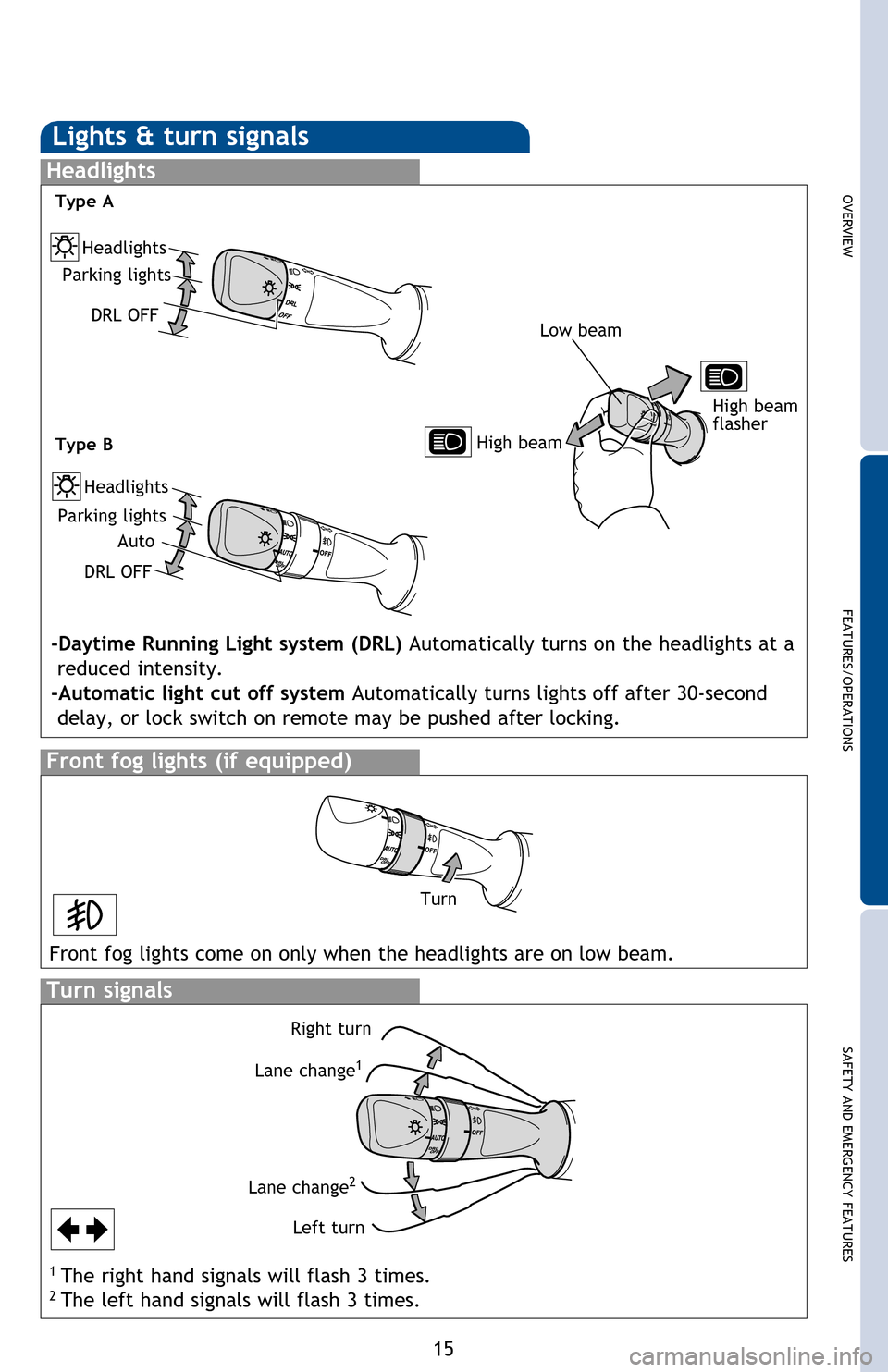
OVERVIEW
FEATURES/OPERATIONS
SAFETY AND EMERGENCY FEATURES
15
The “ENGINE START STOP” switch/ignition switch must be in the “ACC” or “ON”
position for use.
Lights & turn signals
Turn signals
Headlights
High beam
Front fog lights (if equipped)
Headlights
-Daytime Running Light system (DRL) Automatically turns on the headlights at a reduced intensity.
-Automatic light cut off system Automatically turns lights off after 30-second delay, or lock switch on remote may be pushed after locking.
Parking lights
Right turn
Lane change
1
Lane change2
Left turn High beam
flasher
Auto
DRL OFF
Turn
Front fog lights come on only when the headlights are on low beam.
Type B
Type A
Headlights
Parking lights
DRL OFF
Low beam
1 The right hand signals will flash 3 times.2 The left hand signals will flash 3 times.
127601_2013Camry.indd 1511/19/12 10:30 PM
Page 28 of 32
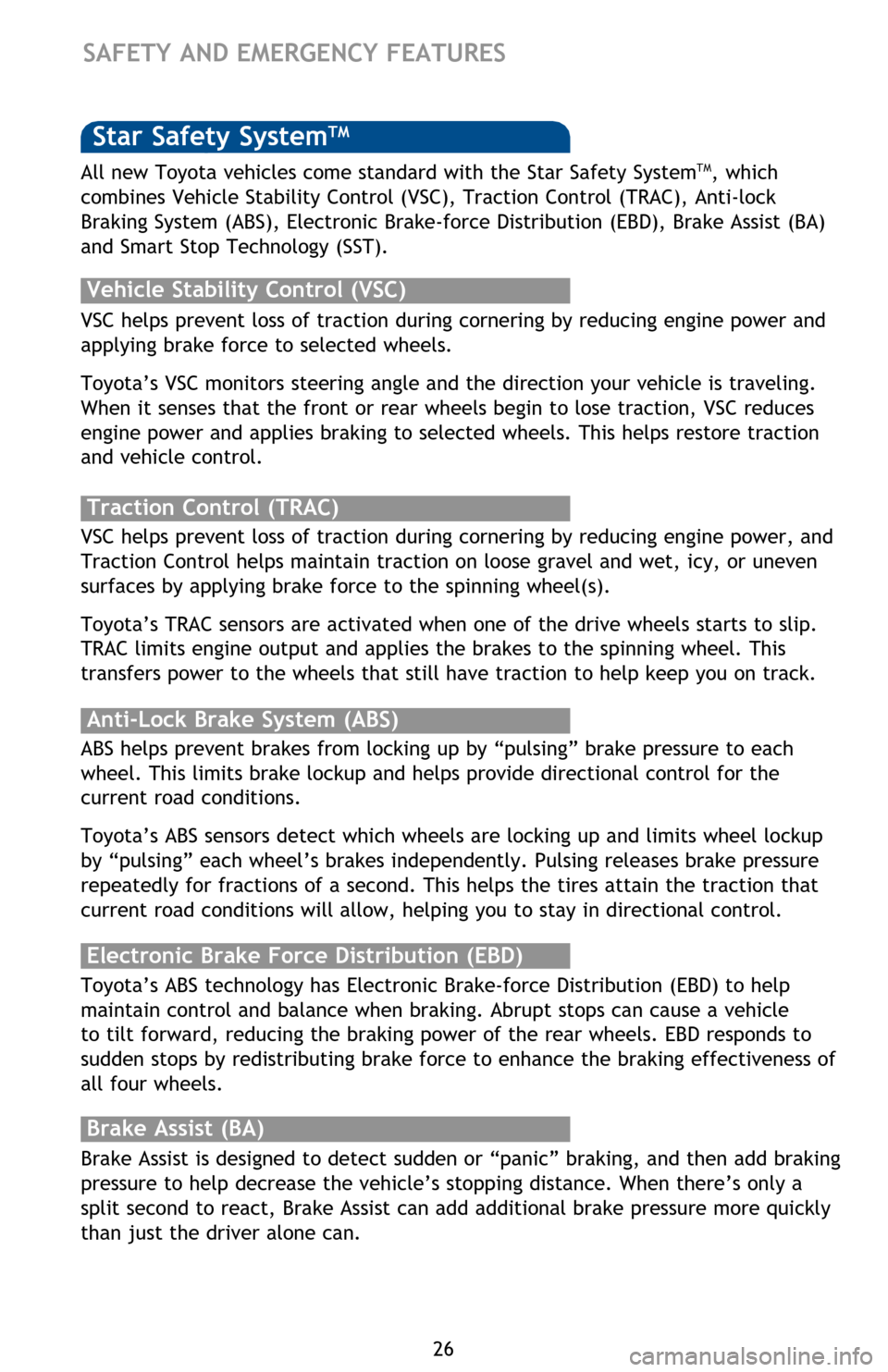
26
Star Safety SystemTM
VSC helps prevent loss of traction during cornering by reducing engine power and
applying brake force to selected wheels.
Toyota’s VSC monitors steering angle and the direction your vehicle is traveling.
When it senses that the front or rear wheels begin to lose traction, VSC reduces
engine power and applies braking to selected wheels. This helps restore traction
and vehicle control.
Vehicle Stability Control (VSC)
Anti-Lock Brake System (ABS)
ABS helps prevent brakes from locking up by “pulsing” brake pressure to each
wheel. This limits brake lockup and helps provide directional control for the
current road conditions.
Toyota’s ABS sensors detect which wheels are locking up and limits wheel lockup
by “pulsing” each wheel’s brakes independently. Pulsing releases brake pressure
repeatedly for fractions of a second. This helps the tires attain the traction that
current road conditions will allow, helping you to stay in directional control.
Brake Assist (BA)
Brake Assist is designed to detect sudden or “panic” braking, and then add braking
pressure to help decrease the vehicle’s stopping distance. When there’s only a
split second to react, Brake Assist can add additional brake pressure more quickly
than just the driver alone can. VSC helps prevent loss of traction during cornering by reducing engine power, and
Traction Control helps maintain traction on loose gravel and wet, icy, or uneven
surfaces by applying brake force to the spinning wheel(s).
Toyota’s TRAC sensors are activated when one of the drive wheels starts to slip.
TRAC limits engine output and applies the brakes to the spinning wheel. This
transfers power to the wheels that still have traction to help keep you on track.
Traction Control (TRAC)
Electronic Brake Force Distribution (EBD)
Toyota’s ABS technology has Electronic Brake-force Distribution (EBD) to help
maintain control and balance when braking. Abrupt stops can cause a vehicle
to tilt forward, reducing the braking power of the rear wheels. EBD responds to
sudden stops by redistributing brake force to enhance the braking effectiveness of
all four wheels.
SAFETY AND EMERGENCY FEATURES
All new Toyota vehicles come standard with the Star Safety SystemTM, which
combines Vehicle Stability Control (VSC), Traction Control (TRAC), Anti-lock
Braking System (ABS), Electronic Brake-force Distribution (EBD), Brake Assist (BA)
and Smart Stop Technology (SST).
There are two types of Toyota floor mats: carpeted and all-weather. Each vehicle
has model-specific floor mats. Installation is easy.
To keep your floor mat properly positioned, follow these steps:
• Only use floor mats designed for your specific model.
• Use only one floor mat at a time, using the retaining hooks to keep the mat in place.
• Install floor mats right side up.
Floor mat installation
Smart Stop Technology automatically reduces driving torque when the accelerator
and brake pedals are pressed simultaneously under certain conditions.
SST engages when the accelerator is depressed first and the brakes are applied
firmly for longer than one-half second at speeds greater than five miles per hour.
SST doesn’t engage if the brake pedal is depressed before the accelerator pedal,
allowing vehicles to start on a steep hill and safely accelerate without rolling
backward.
Smart Stop Technology (SST)
127601_2013Camry.indd 2611/19/12 10:31 PM
Page 29 of 32
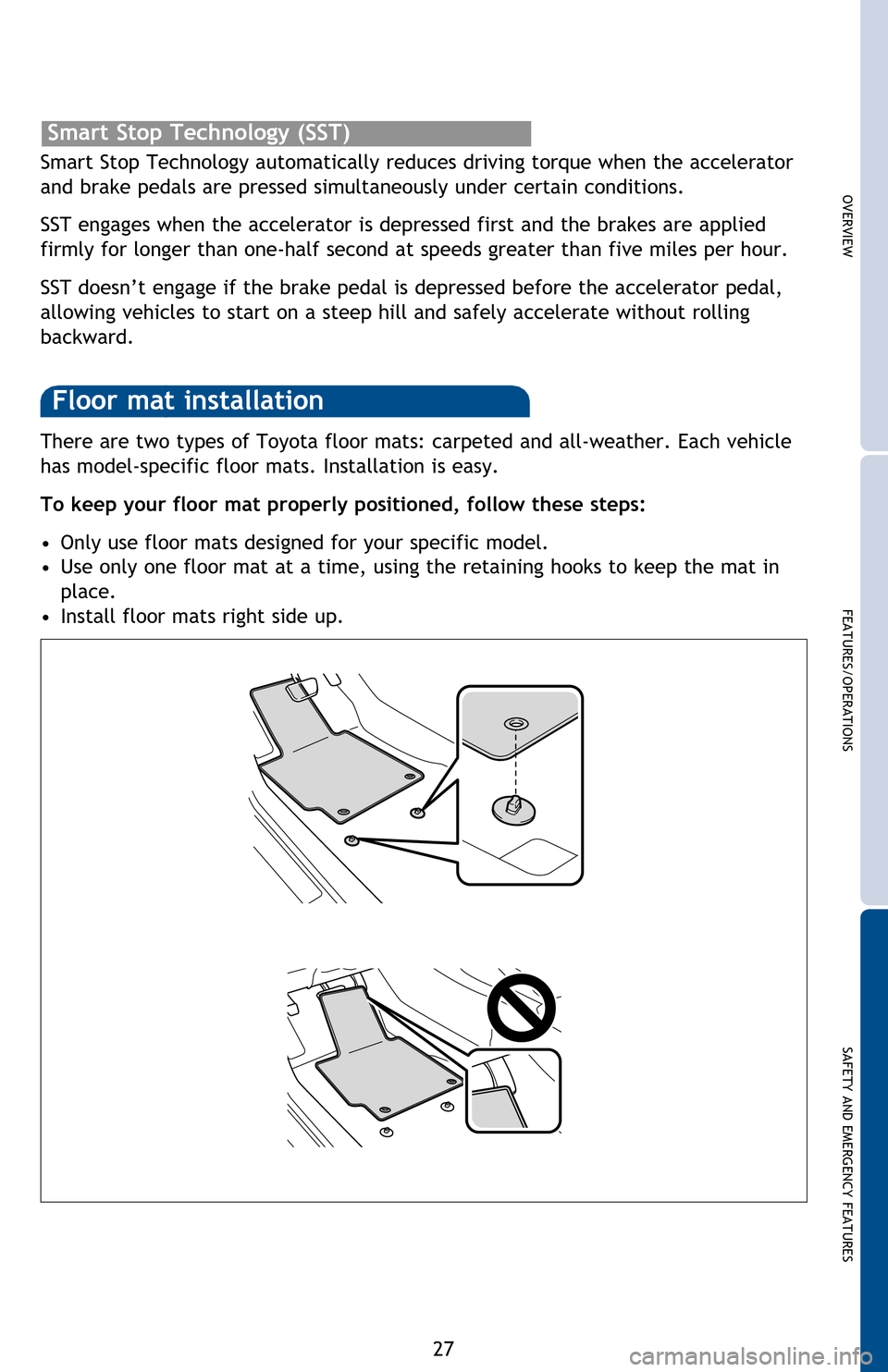
OVERVIEW
FEATURES/OPERATIONS
SAFETY AND EMERGENCY FEATURES
27
VSC helps prevent loss of traction during cornering by reducing engine power and
applying brake force to selected wheels.
Toyota’s VSC monitors steering angle and the direction your vehicle is traveling.
When it senses that the front or rear wheels begin to lose traction, VSC reduces
engine power and applies braking to selected wheels. This helps restore traction
and vehicle control.
ABS helps prevent brakes from locking up by “pulsing” brake pressure to each
wheel. This limits brake lockup and helps provide directional control for the
current road conditions.
Toyota’s ABS sensors detect which wheels are locking up and limits wheel lockup
by “pulsing” each wheel’s brakes independently. Pulsing releases brake pressure
repeatedly for fractions of a second. This helps the tires attain the traction that
current road conditions will allow, helping you to stay in directional control.
Brake Assist is designed to detect sudden or “panic” braking, and then add braking
pressure to help decrease the vehicle’s stopping distance. When there’s only a
split second to react, Brake Assist can add additional brake pressure more quickly
than just the driver alone can. VSC helps prevent loss of traction during cornering by reducing engine power, and
Traction Control helps maintain traction on loose gravel and wet, icy, or uneven
surfaces by applying brake force to the spinning wheel(s).
Toyota’s TRAC sensors are activated when one of the drive wheels starts to slip.
TRAC limits engine output and applies the brakes to the spinning wheel. This
transfers power to the wheels that still have traction to help keep you on track.
Toyota’s ABS technology has Electronic Brake-force Distribution (EBD) to help
maintain control and balance when braking. Abrupt stops can cause a vehicle
to tilt forward, reducing the braking power of the rear wheels. EBD responds to
sudden stops by redistributing brake force to enhance the braking effectiveness of
all four wheels.
SAFETY AND EMERGENCY FEATURES
All new Toyota vehicles come standard with the Star Safety SystemTM, which
combines Vehicle Stability Control (VSC), Traction Control (TRAC), Anti-lock
Braking System (ABS), Electronic Brake-force Distribution (EBD), Brake Assist (BA)
and Smart Stop Technology (SST).
There are two types of Toyota floor mats: carpeted and all-weather. Each vehicle
has model-specific floor mats. Installation is easy.
To keep your floor mat properly positioned, follow these steps:
• Only use floor mats designed for your specific model.
• Use only one floor mat at a time, using the retaining hooks to keep the mat in place.
• Install floor mats right side up.
Floor mat installation
Smart Stop Technology automatically reduces driving torque when the accelerator
and brake pedals are pressed simultaneously under certain conditions.
SST engages when the accelerator is depressed first and the brakes are applied
firmly for longer than one-half second at speeds greater than five miles per hour.
SST doesn’t engage if the brake pedal is depressed before the accelerator pedal,
allowing vehicles to start on a steep hill and safely accelerate without rolling
backward.
Smart Stop Technology (SST)
127601_2013Camry.indd 2711/19/12 10:31 PM